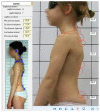Regular School Sport versus Dedicated Physical Activities for Body Posture-A Prospective Controlled Study Assessing the Sagittal Plane in 7-10-Year-Old Children
- PMID: 35268346
- PMCID: PMC8911120
- DOI: 10.3390/jcm11051255
Regular School Sport versus Dedicated Physical Activities for Body Posture-A Prospective Controlled Study Assessing the Sagittal Plane in 7-10-Year-Old Children
Abstract
Body posture develops during the growing period and can be documented using trunk photography. The study aims to evaluate the body posture in children aged 7-10 years undergoing a dedicated physical activities program versus regular school sport. A total of 400 children, randomly chosen from a cohort of 9300 participating in a local scoliosis screening program, were evaluated twice at a one-year interval. A total of 167 children were involved in regular school sport (control group), while 233 received both school sport and a dedicated physical activities program (intervention group). Standardized photographic habitual body posture examination was performed at enrollment (T0) and one-year after (T1). Sacral slope (SS), lumbar lordosis (LL), thoracic kyphosis (TK), chest inclination (CI), and head protraction (HP) were measured. At T0, the body posture parameters did not differ between groups. At T1 in the controls, all five parameters tended to deteriorate (insignificant): SS p = 0.758, LL p = 0.38, TK p = 0.328, CI p = 0.081, and HP p = 0.106. At T1 in the intervention group, the SS decreased (p = 0.001), the LL tended to decrease (p = 0.0602), and the TK, CI, and HP remained unaltered. At T1, the SS and LL parameter differed between groups statistically (p = 0.0002 and p = 0.0064, respectively) and clinically (2.52° and 2.58°, respectively). In 7-10-year-old children, participation in dedicated physical activities tends to improve their body posture compared to regular school sport.
Keywords: body posture; corrective exercises; digital photography; sports activity.
Conflict of interest statement
The authors declare no conflict of interest.
Figures
Similar articles
-
[CHANGE AND CLINICAL SIGNIFICANCE OF CERVICAL SPINE SAGITTAL ALIGNMENT OF ADOLESCENT IDIOPATHIC SCOLIOSIS].Zhongguo Xiu Fu Chong Jian Wai Ke Za Zhi. 2016 Mar;30(3):336-42. Zhongguo Xiu Fu Chong Jian Wai Ke Za Zhi. 2016. PMID: 27281880 Chinese.
-
Compensatory Mechanism of Maintaining the Sagittal Balance in Degenerative Lumbar Scoliosis Patients with Different Pelvic Incidence.Orthop Surg. 2020 Dec;12(6):1685-1692. doi: 10.1111/os.12805. Epub 2020 Sep 21. Orthop Surg. 2020. PMID: 32954650 Free PMC article.
-
Sagittal alignment of the cervical spine in adolescent idiopathic scoliosis: a comparative study of 42 adolescents with idiopathic scoliosis and 24 normal adolescents.Eur Spine J. 2016 Oct;25(10):3226-3233. doi: 10.1007/s00586-016-4701-3. Epub 2016 Jul 18. Eur Spine J. 2016. PMID: 27432428
-
Two-dimensional digital photography for child body posture evaluation: standardized technique, reliable parameters and normative data for age 7-10 years.Scoliosis Spinal Disord. 2017 Dec 19;12:38. doi: 10.1186/s13013-017-0146-7. eCollection 2017. Scoliosis Spinal Disord. 2017. PMID: 29276784 Free PMC article. Review.
-
Preoperative Sagittal Spinal Profile of Adolescent Idiopathic Scoliosis Lenke Types and Non-Scoliotic Adolescents: A Systematic Review and Meta-Analysis.Spine (Phila Pa 1976). 2019 Jan 15;44(2):134-142. doi: 10.1097/BRS.0000000000002748. Spine (Phila Pa 1976). 2019. PMID: 29927859
Cited by
-
Epidemiological trends and predictive factors of adolescent scoliosis in qingdao: insights from a Large-scale screening program (2022-2024).Eur Spine J. 2025 Aug 14. doi: 10.1007/s00586-025-09245-6. Online ahead of print. Eur Spine J. 2025. PMID: 40804499
References
-
- Angelakopoulos G., Savelsbergh G.J., Bennett S., Davids K., Haralambos T., George G. Systematic review regarding posture development from infancy to adulthood. Hell. J. Phys. Educ. Sport Sci. 2008;68:35–43.
-
- Stolinski L., Kozinoga M., Czaprowski D., Tyrakowski M., Cerny P., Suzuki N., Kotwicki T. Two-dimensional digital photography for child body posture evaluation: Standardized technique, reliable parameters and normative data for age 7–10 years. Scoliosis Spinal Disord. 2017;12:38. doi: 10.1186/s13013-017-0146-7. - DOI - PMC - PubMed
Grants and funding
LinkOut - more resources
Full Text Sources
Research Materials
Miscellaneous


